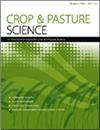Salinity, alkalinity and their combined stress effects on germination and seedling growth attributes in oats (Avena sativa)
IF 1.9
4区 农林科学
Q2 AGRICULTURE, MULTIDISCIPLINARY
引用次数: 1
Abstract
ABSTRACT Context. Under natural field conditions, plants confront the co-occurrence of stresses. A comprehensive insight into combined-stress tolerance is requisite to developing stress resilience in cultivars of oats (Avena sativa L.) for saline–alkaline soil. Aim. This study was undertaken to characterise diverse oat genotypes for seedling growth attributes under two saline and alkaline concentrations and under combined saline–alkaline conditions. Methods. We screened 105 accessions of the genus Avena with the following treatments: control, reverse osmosis water; moderate salinity (50 mM); high salinity (100 mM); moderate alkalinity (15 mM); high alkalinity (30 mM); combined moderate salinity–alkalinity (50 mM + 15 mM); and combined high salinity–alkalinity (100 mM + 30 mM). For saline treatments, NaCl and Na2SO4 salts were used in equimolar concentrations, and for alkaline treatments, NaHCO3 and Na2CO3. Key results. Analysis of variance showed significant (P ≤ 0.001) variation among treatments and genotypes. Principal component analysis revealed 83.3% of the total genetic variation accounted for in the first two principal components. Correlation analysis showed a significant positive correlation between final germination percentage and seedling vigour index. Stress tolerance index identified tolerant and sensitive oat genotypes under high saline and alkaline stress, and multi-trait stability analysis confirmed the stability of performance of some genotypes under the imposed treatments. Conclusions.According to the stress tolerance index and multi-trait stability analysis, genotypes IG-20-477, OS-377, IG-20-798 and IG-20-575 were found suitable for high saline–alkaline stress. Implications.The identified tolerant oat genotypes can be used as donors for the development of stress-resilient oat cultivars, and for generating mapping populations in oat.盐度、碱度及其复合胁迫对燕麦种子萌发和幼苗生长特性的影响
抽象的上下文。在自然的田间条件下,植物面临着逆境的共存。对盐碱地燕麦品种的综合抗逆性研究是提高其抗逆性的必要条件。的目标。研究了不同燕麦基因型在盐碱两种浓度和盐碱复合条件下的幼苗生长特性。方法。采用反渗透水处理,筛选了105份苜蓿属植物;中等盐度(50 mM);高盐度(100 mM);中等碱度(15mm);高碱度(30mm);中盐碱度组合(50 mM + 15 mM);高盐碱性组合(100mm + 30mm)。盐水处理采用等摩尔浓度的NaCl和Na2SO4盐,碱性处理采用NaHCO3和Na2CO3盐。关键的结果。方差分析显示不同处理和基因型间差异显著(P≤0.001)。主成分分析表明,前两个主成分占总遗传变异的83.3%。相关分析表明,最终发芽率与幼苗活力指数呈极显著正相关。胁迫耐受性指标鉴定出高盐、高碱胁迫下耐受性和敏感性的燕麦基因型,多性状稳定性分析证实部分基因型在高盐、高碱胁迫下表现稳定。结论。根据抗逆性指数和多性状稳定性分析,筛选出适合高盐碱胁迫的基因型为IG-20-477、OS-377、IG-20-798和IG-20-575。的影响。鉴定出的耐受性燕麦基因型可作为抗逆性燕麦品种开发的供体,并可用于建立燕麦的定位群体。
本文章由计算机程序翻译,如有差异,请以英文原文为准。
求助全文
约1分钟内获得全文
求助全文
来源期刊

Crop & Pasture Science
AGRICULTURE, MULTIDISCIPLINARY-
CiteScore
4.20
自引率
15.80%
发文量
111
审稿时长
3 months
期刊介绍:
Crop and Pasture Science (formerly known as Australian Journal of Agricultural Research) is an international journal publishing outcomes of strategic research in crop and pasture sciences and the sustainability of farming systems. The primary focus is broad-scale cereals, grain legumes, oilseeds and pastures. Articles are encouraged that advance understanding in plant-based agricultural systems through the use of well-defined and original aims designed to test a hypothesis, innovative and rigorous experimental design, and strong interpretation. The journal embraces experimental approaches from molecular level to whole systems, and the research must present novel findings and progress the science of agriculture.
Crop and Pasture Science is read by agricultural scientists and plant biologists, industry, administrators, policy-makers, and others with an interest in the challenges and opportunities facing world agricultural production.
Crop and Pasture Science is published with the endorsement of the Commonwealth Scientific and Industrial Research Organisation (CSIRO) and the Australian Academy of Science.
 求助内容:
求助内容: 应助结果提醒方式:
应助结果提醒方式:


